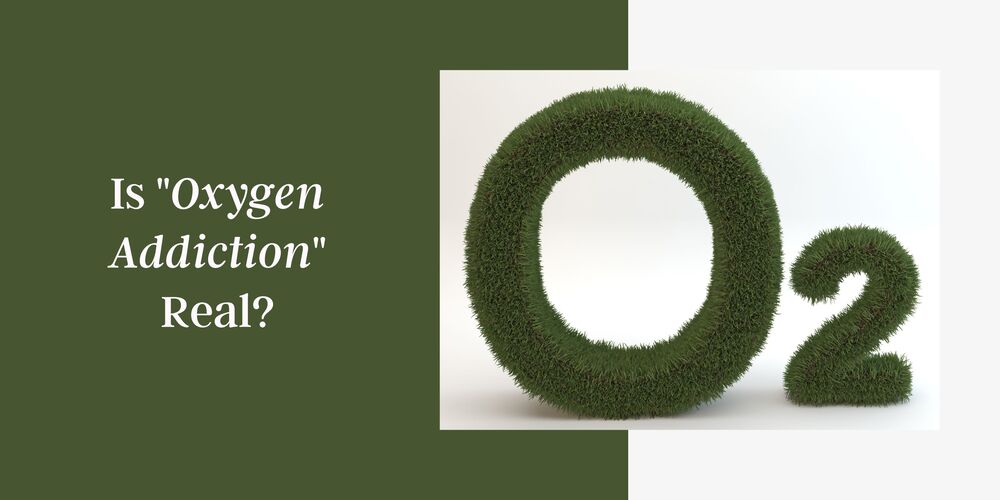Addicted To Oxygen? Everyone Is "Addicted" To Oxygen.
Is "oxygen addiction" real? Read on to find out what Dr.Danielle Rose, MD, has to say about oxygen dependency.
From Mike:
"EVERYONE is "addicted" to oxygen. We are dead without it for more than a few minutes. The word addiction in this regard is mostly stemming from misunderstanding or as a scare word.
In the spirit of truth and helping yourselves, friends, and loved ones gain and maintain optimal health, let's try and address this more intelligently. "
Dr. Rose:
"We currently breathe roughly 21% oxygen, and we know that breathing less than that is a cause of symptoms and problems with hypoxia or the body's various tissues not getting enough oxygen to function properly.
The body gets this oxygen through the lungs which take in the oxygen from the air and release the carbon dioxide from the body's metabolic processes. The body has a certain ability to adapt to more or less of what it needs to function and does so, but often not optimally.
It can do so much more easily with small changes than with large changes, so we can gradually reduce the amount of oxygen in your air and your body can gradually adapt as it does with changing altitude or when chronic problems affect how well your lungs function but eventually it will no longer be able to function normally with lower and lower amounts.
Same holds true for when we intervene with adding more oxygen or many other substances, the body gradually adapts and shifts its system function to having more.
Exercise (physical, breathing exercises, activity level, work of breathing are all included here) vs. rest (rest when healthy, rest when lungs are sick also will have large variations in how well oxygen is absorbed by the body) with and without extra oxygen also affect various aspects of how well.
The lungs absorb oxygen, how much ventilation is occurring and how much perfusion of blood is occurring, all of which need to be in place for maximal oxygen uptake by the lungs.
After uptake by the lungs and onto the hemoglobin, the tissues need to be able to absorb it into the cells and into the mitochondria of the cells, all of which are affected by thousands of different metabolic processes.
Unlike oxygen in the hemoglobin, which can be measured by a pulse oximetry device, the oxygen actually in the tissues is not easily measured and much is unknown about various problems keeping adequate oxygen from getting into the tissues and cell mitochondria. Many who study oxygen extensively talk a lot about this absorption/perfusion.
Most of the time, extra oxygen is done for patients who have a serious lung problem. The extra oxygen helps the body overcome some of its limitations from illness and get enough oxygen to function and heal. Clinically, this results in the patient feeling better because there is less stress of breathing and improved cellular oxygenation.
As the patient improves, the oxygen is weaned to allow the body a chance to gradually get used to provide the same functions with less help, just like you don't walk on a broken leg without a cast and then you don't run a marathon right after the cast is removed.
You allow your body to gradually regain better function in slower paces. We know that just keeping the body on continual oxygen over and above what it is capable of adapting to will result in permanent damage to the lungs, called pulmonary oxygen toxicity, which is why continuous oxygen is not recommended unless your life is in jeopardy without it.
So, there is a range of oxygen that is helpful for the body where too little or too much causes problems. This is called the therapeutic window as it is with other substances.
This can differ between patients or even in the same patient over time and over the course of illness, depending on the patient, time in the patient's life, genetics, metabolism, exercise, etc.
Intermittent exposure to higher oxygen with many hours of "normoxic" breathing between the higher exposures has not resulted in pulmonary oxygen toxicity.
Many have reported improved function with intermittent oxygen especially when done with exercise. So, as with any food, supplement, or medication, oxygen needs to be taken carefully, in moderation and with consideration of all the variables affecting your personal health.
From Mike:
One key factor may be antioxidants.
Oxygen is not only necessary for every cellular action in your body, but it also creates free radicals as a byproduct of O2 combustion. Kind of like what smoke is to fire. Antioxidants aid in cellular metabolism as well as offset this "smoke".
Strictly speaking, the more O2 we uptake, the more antioxidants we should have. We rarely hear of an oxygen-prescribing MD recommending antioxidants to anyone on oxygen. That may or may not stem from a traditional medical model that often states/believes nutrition doesn't have much or anything to do with health.
We suggest that if you want to optimize your O2 utilization, you increase your antioxidants such as A, B, C, D, E, Coenzyme Q10, germanium, superoxide dismutase (SOD), and organic sulphur.
Certain kinds of green foods can aid in transporting extra oxygen. Ask your favorite health professional for a good antioxidant and green food oxygen transport formula.
Combine the chemistry and O2E2 oxygen generators plus the mechanics Optimal Breathing Kit for major steps toward health and longevity.




